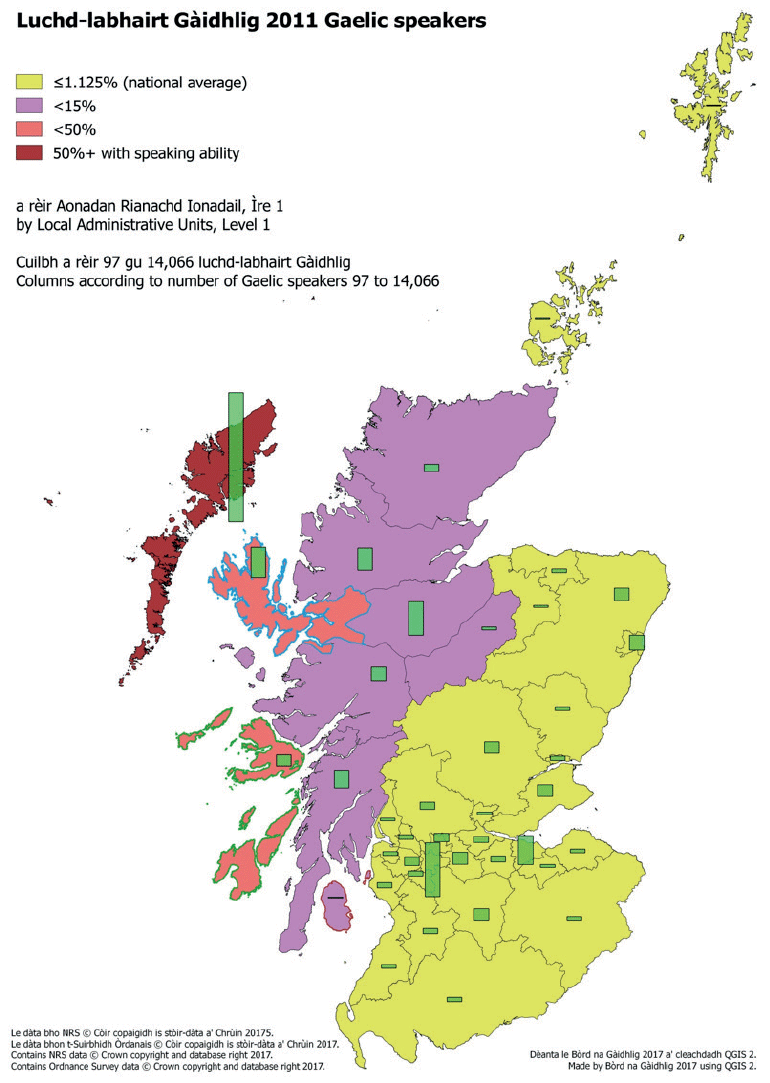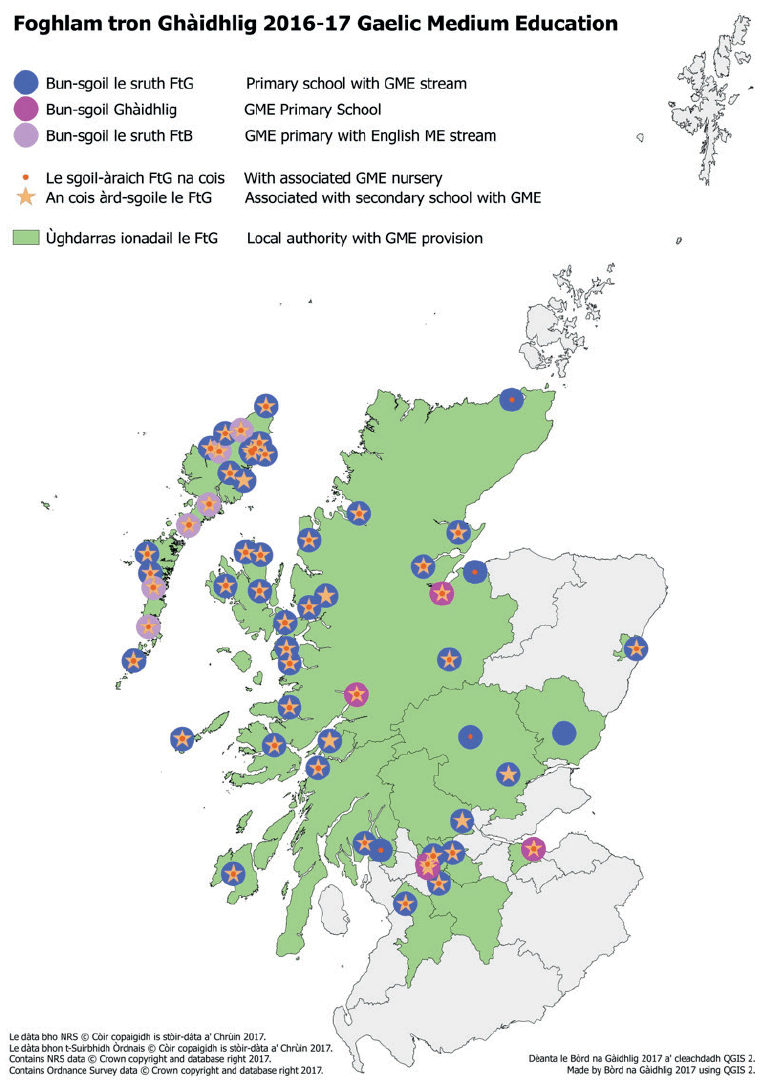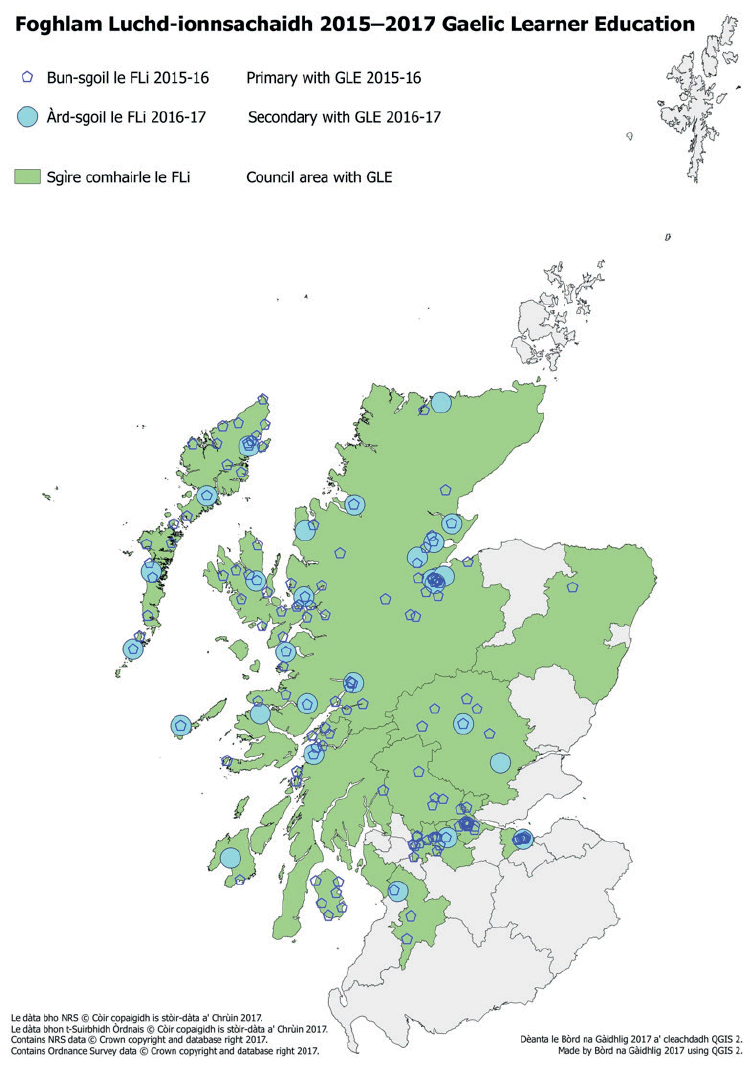Scottish Government Gaelic Language Plan 2016-2021
How the Scottish Government supports Gaelic in its operations, to ensure the language has a sustainable future in Scotland.
Chapter I: Introduction
Overview of the Gaelic Language (Scotland) Act 2005 and the preparation of Gaelic Language Plans
The Gaelic Language (Scotland) Act 2005
The Gaelic Language (Scotland) Act 2005 was passed by the Scottish Parliament with a view to securing the status of the Gaelic language as an official language of Scotland commanding equal respect to the English language.
This is a critical time for the future of Gaelic. The position of the language is extremely fragile and the declining numbers of those speaking Gaelic fluently threatens the survival of Gaelic as a living language in Scotland. It is essential that steps are taken to create a sustainable future for Gaelic in Scotland.
One of the key features of the 2005 Act is the provision enabling Bòrd na Gàidhlig (the Scottish Government's principal Gaelic development body) to require public bodies to prepare Gaelic Language Plans. This provision was designed to ensure that the public sector in Scotland plays its part in creating a sustainable future for Gaelic by raising its status and profile and creating practical opportunities for its use.
The requirement to prepare a Gaelic Language Plan
The requirement for a public body to prepare a Gaelic Language Plan is initiated by Bòrd na Gàidhlig issuing a formal notice to that effect under section 3 of the 2005 Act. Following our initial notice in 2006, the Scottish Government's Gaelic Language Plan was granted approval by the Bòrd and came in to operation in June 2010.
The planning cycle continues to develop through the review process with organisations expected to maintain current commitments while considering how they can develop a second iteration of their Plan. This is where the Scottish Government is in this circular development.
Key considerations when preparing a Gaelic Language Plan
The 2005 Act sets out a number of specific criteria which must be taken into account by bodies preparing Gaelic Language Plans. These are designed to ensure that Gaelic Language Plans which are prepared are comprehensive, consistent and appropriate to the particular circumstances of the body preparing it.
(i) the extent to which the persons in relation to whom the authority's functions are exercisable use the Gaelic language, and the potential for developing the use of the Gaelic language in connection with the exercise of those functions
This consideration is designed to ensure that the Gaelic Language Plans prepared by public bodies take account both of the existing number of speakers within their area of operation, and their potential to develop the use of the language. Generally speaking, the expectation is that public bodies with significant numbers of Gaelic speakers within their area of operation will develop stronger Gaelic Language Plans.
The Scottish Government's area of operation is all of Scotland, and therefore the primary function of this plan is in supporting the National Gaelic Language Plan (see (iii)).
(ii) statutory guidance on the preparation of Gaelic Language Plans published by Bòrd na Gàidhlig under section 8 of the 2005 Act
Bòrd na Gàidhlig has published statutory guidance under section 8 of the 2005 Act, which provides advice on how Gaelic Language Plans should be structured, and on the content which public authorities should include in their Plans.
(iii) the National Gaelic Language Plan
The National Gaelic Language Plan is a statutory document produced by Bòrd na Gàidhlig under section 2 of the 2005 Act, with the third iteration due to be consulted on and published in 2017. The National Plan offers a holistic overview of Gaelic development needs, covering language acquisition, language usage, language status and language corpus issues. It sets out priorities for Gaelic development, and identifies bodies which are key to achieving them. The Scottish Government has a key role in supporting Bòrd na Gàidhlig with this process, as set out in Chapter III.
(iv) any representations made to the public body preparing its Plan about how it uses Gaelic
This provision is designed to ensure that public bodies take into account the views of interested parties in the preparation of their Gaelic Language Plans. The principal means of obtaining these views by the Scottish Government is through public consultation on its draft Plan.
(v) the principle of equal respect
The principle of equal respect was incorporated into the 2005 Act by the Scottish Parliament as a positive statement about the value and worth of Gaelic, in recognition of the fact that users of Gaelic aspire to use Gaelic as normally as possible in their lives, that there should be a generosity of spirit towards Gaelic across Scotland, and that the language should not suffer from any lack of respect either at an individual or corporate level.
The Bòrd's guidance states that giving Gaelic equal respect does not automatically mean identical treatment for Gaelic and English, or that a particular level of Gaelic provision must be made available in all circumstances. Instead, it encourages public bodies to endeavour, whatever the particular linguistic landscape they face, to be supportive and generous to Gaelic development and to prepare their Gaelic Language Plans with a view to facilitating the use of Gaelic to the greatest extent that is appropriate to their individual circumstances.
When delivering services in Gaelic, we will ensure they are of an equal standard and quality as those they provide in English.
Consultation on a draft Gaelic Language Plan
The 2005 Act requires public bodies to bring the preparation of its Gaelic Language Plan to the intention of those with an interest in it. To do so, the Scottish Government consulted on a draft of its Gaelic Language Plan during May and June 2015. Responses received to this consultation and a report of its findings can be viewed at https://consult.scotland.gov.uk/curraicealam-measadh-gaidhlig/consultation-on-the-draft-scottish-government-gael.
Approval of the Scottish Government Gaelic Language Plan
The Scottish Government Gaelic Language Plan was approved by Bòrd na Gàidhlig on 5 October 2016.
Overview of the functions of the Scottish Government
The Scottish Government is the devolved government for Scotland. The Scottish Government (formerly known as the Scottish Executive) was established in 1999, following the first elections to the Scottish Parliament. The Scottish Government is led by a First Minister nominated by the Parliament who in turn appoints the other Scottish Ministers.
Scottish Government civil servants are accountable to Scottish Ministers, who are themselves accountable to the Scottish Parliament. The senior board of the Scottish Government, the Strategic Board, is chaired by the Permanent Secretary and is made up of the Directors-General of the core Directorates of the Scottish Government, the Chief Scientific Advisor, the Chief Economic Advisor, the Chief Executive of the Crown Office and Procurator Fiscal Service ( COPFS), together with three Non-Executive Directors.
The Scotland Acts (1998, 2012 and 2016) define the matters that are reserved to the UK Parliament. Any matter not so reserved, or otherwise defined in the Act as being outwith the competence of the Scottish Parliament, is devolved. Currently devolved matters are listed below.
Currently devolved matters include:
- health
- education and training
- local government
- social work
- housing
- planning
- tourism, economic development and financial assistance to industry
- some aspects of transport, including the Scottish road network, bus policy and ports and harbours
- law and home affairs, including most aspects of criminal and civil law, the prosecution system and the courts
- the Police and Fire services
- the environment
- natural and built heritage
- agriculture, forestry and fishing
- sport and the arts
- statistics, public registers and records
- certain tax and welfare powers (following Scotland Act 2016)
The Scottish Government's main offices are located in Edinburgh, at Victoria Quay, St Andrew's House and Saughton House; and in Glasgow, at Atlantic Quay and the Europa Building. In addition, we have several area offices stretching from Kirkwall in the north to Stranraer in the south.
The work of the Scottish Government is carried out by:
- The Core Scottish Government - the mainstream civil service in Scotland with the core Directorates of Learning and Justice; Finance; Economy; Health and Social Care; Communities; Strategy and External Affairs; and the Office of the Permanent Secretary.
- Public Bodies - executive agencies, non-departmental public bodies ( NDPBs) and other organisations which carry out a variety of statutory, regulatory and advisory functions on behalf of the Scottish Government. Further information, including a list of current Scottish public bodies can be found at http://www.gov.scot/Topics/Government/public-bodies.
- Task Forces - advisory bodies established by Ministers to investigate and report on particular issues. Task Forces have a short lifespan, normally around a year or so, and are abolished once they have reported.
Gaelic in the Scottish Government's Area of Operation
The Scottish Government's area of operation is all of Scotland. It therefore follows that all of Scotland's Gaelic speakers and Gaelic communities are within the area in which the Scottish Government operates including districts in which persons able to understand, speak, read or write Gaelic form a majority of the population, as well as areas where Gaelic is experiencing growth. Organisations supported by the Scottish Government in relation to the National Gaelic Language Plan are listed in Chapter III.
National Demographics - Number of Gaelic Speakers
Results from the 2011 Census have shown that the decline in the number of Gaelic speakers has slowed since 2001. The total number of people recorded as being able to speak and/or read and/or understand Gaelic was 87,056. Of these 58,000 people (1.1% of the population) aged three and over in Scotland were able to speak Gaelic. This is a slight fall from 59,000 (1.2% of the population) in the 2001 Census which compares favourably to the previous Census results which recorded an 11% drop in speakers.
In 2011, the proportion of the population aged three and over in Scotland who could speak, read, write or understand Gaelic was 1.7% (87,056), compared with 1.9% (92,000) in 2001. Within this group, the number of people who could speak, read, understand and write Gaelic in 2011 was 32,000, 0.6% of the population aged three and over; this was the same proportion as in 2001.
While there was a decrease in the proportion of people able to speak Gaelic in most age groups there was an increase in those groups aged under 20 years. In total, there was a 0.1 percentage point increase in Gaelic speakers between 2001 and 2011 for the 3-19 age range.
Gaelic speakers are spread throughout Scotland. Of those who identified themselves as Gaelic speakers in the 2011 Census the council areas with the highest proportions able to speak Gaelic were found to be in Na h-Eileanan Siar (52%), Highland (5%) and Argyll & Bute (4%). There is also a high degree of urbanisation within the Gaelic speaking community with large numbers of Gaelic speakers living in Aberdeen, Edinburgh, Greater Glasgow and Inverness.
The map on the next page shows the concentration and numbers of Gaelic speakers in Scotland, according to the 2011 Census. Further information is available from National Records of Scotland, on the website www.scotlandscensus.gov.uk.

Gaelic Education
A key element of Gaelic in Scotland is Gaelic Education found in various forms and levels across Scotland. There were 3,004 pupils in Gaelic medium primary education nationally in session 2015-16, with 1,003 attending Gaelic medium nurseries. Both these groups have grown since the publication of our first Gaelic Language Plan in 2010. In addition to Gaelic medium education, 11 Councils provide 7,772 pupils in English medium primary schools the opportunity to learn Gaelic through Gaelic Learners in the Primary School ( GLPS). Again, the number of children who have benefitted from this opportunity has grown in the past five years.
At secondary level, 1,193 pupils received Gaelic medium secondary education of some form in session 2015-16. This number is expected to rise over the course of this plan with more subjects being offered to more areas through e-learning.
The maps on the following pages show the locations of Gaelic education provision currently available in Scotland. More detail on these statistics is available from Bòrd nan Gàidhlig at www.gaidhlig.scot.


Contact
Email: Ruaraidh MacIntyre
Phone: 0300 244 4000 – Central Enquiry Unit
The Scottish Government
St Andrew's House
Regent Road
Edinburgh
EH1 3DG
There is a problem
Thanks for your feedback